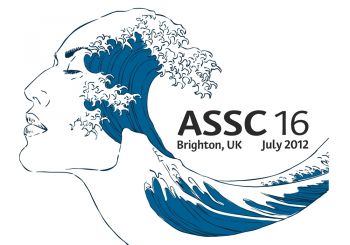Secrets of the mind to be unlocked at consciousness conference
Posted on behalf of: Sackler Centre for Consciousness Science
Last updated: Friday, 15 June 2012

An international conference dedicated to examining the complex brain processes underlying consciousness is being hosted in Brighton next month by the University’s Sackler Centre for Consciousness Science.
Understanding the biological basis of conscious experience is one of the great challenges for 21st century science.
Neuroscientists, psychologists, psychiatrists, philosophers and others involved in this rapidly accelerating area of research will be descending on Brighton’s Dome and Corn Exchange for the 16th Annual Meeting of the Association for the Scientific Study of Consciousness (ASSC16) from 2-6 July. An additional ‘satellite’ symposium on neuropsychiatry will take place at the University on 7 July.
Awarded to Sussex in a competitive bidding process in 2010, the ASSC is the premier international meeting in its field, and is hosted in Europe only once every three years.
The programme of keynote talks, themed symposia and satellite sessions will cover topics such as implicit learning and perception, altered states, and time perception.
Dr Anil Seth, Co-director of the Sackler Centre and chair of the conference, says: “Developments in consciousness science are now yielding clinical insights for real practical importance across a wide range of neurological and psychiatric conditions.
“A true test of the value of science is its ability to enhance the human condition and the study of consciousness is now contributing here as well.”
The conference opens with a special one-day “expo” at the Corn Exchange, where researchers will be talking about and demonstrating their work for free to members of the public. The event, State of Mind, is open from 10am-5pm on 30 June. Other public events throughout the week will ensure that ASSC16 is a true citywide celebration of consciousness science.
The Facebook page that has been set up will be updated throughout the meeting. You can also join the live Twitter conversation using the hashtag #ASSC16.
Among more than 400 research projects being discussed at the conference are several by University of Sussex researchers in diverse areas such as synaesthesia, hypnosis, and the connection between emotions and the heart.
They include:
Is this my hand which I see before me?
Dr Keisuke Suzuki will present his work (with Dr Anil Seth) examining the close coupling between our experiences of the external world and of our own body. Dr Suzuki has developed a ‘virtual rubber hand’ illusion in which subjects experience that a hand they are watching in a virtual world is their own. It even changes colour according to their heart beat. Dr Suzuki uses Mircrosoft Kinect, a custom-designed augmented reality system, and physiological sensors, to create the illusion. These experiments are part of a new theory of subjective emotions and conscious presence which have important medical and psychological implications by revealing how bodily self recognition is influenced by basic physiological signals as well as external signals from the world.
What the heart sees
We probably all think that we are more aware of things around us when we are relaxed, and worse when we are more physically tense or aroused. Working with Sackler Centre Co-Director Prof, Hugo Critchley, research fellow Dr Sarah Garfinkel has traced what happens down to the level of individual heartbeats to show how much our internal bodily signals influence consciousness. She showed people pictures of faces with either fearful expressions or neutral expressions, presenting some of the faces just before and some just after individual heartbeats. She found that people’s emotional response to fearful faces, and the brain activity associated with fear, was turned on and off by the timing of the heartbeat. This suggests that internal bodily functions affect how we perceive the world and points to a mechanism by which our heart controls our emotions.
How to make a synaesthete
Dr David Schwartzman and colleagues are investigating whether synaesthesia, a perceptual condition in which a stimulus from one sense involuntarily causes an experience in another sense, is congenital or the result of early developmental learning. Dr Schwartzman put non-synaesthetes through an intensive training regime of memory tasks (40 mins per day, 5 days a week for 8 weeks) to develop strong number-colour associations similar to those found in synaesthesia and found that several participants not only developed robust associations very similar to those displayed in synaesthesia, they also started to exhibit additional synaesthetic-like experiences. These findings argue against a purely congenital view of synaesthesia and suggest that synaesthesia may be able to be learnt. In related research, Dr Nicolas Rothen has recently published findings that show that people with synaesthesia have specific memory advantages compared to non-synaesthetes.
Have a drink. Now look into my eyes …
Rebecca Semmens-Wheeler , Professor Zoltan Dienes and Professor Dora Duka investigated whether it was easier to hypnotise people whose brain activity had been temporarily affected by alcohol. Neuroscience has shown that a region of the frontal lobe cortex of the brain is responsible for being conscious of our mental states. Alcohol is known to impair activity in this part of the brain. In an experiment, participants were given either 0.8mg/kg of alcohol, or a non-alcoholic placebo drink. All participants believed they were given alcohol. They were then hypnotised and given eight hypnotic suggestions. Those who had received the alcoholic drink were more susceptible to hypnotic suggestion than those who had received the placebo. The findings support the idea that impaired frontal lobe activity facilitates hypnotic responding.

